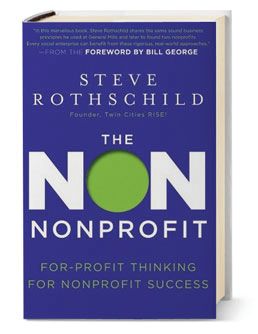Measure Your Value
PART-TIME SARASOTA RESIDENT Steve Rothschild spent an impressive career in the for-profit world, serving as executive vice president of General Mills and launching the Yoplait brand. Then he turned his business savvy toward nonprofit organizations, launching two Minnesota-based human services organizations: Twin Cities RISE and Invest in Outcomes.

Rothschild’s book, The Non Nonprofit: For-Profit Thinking for Nonprofit Success, details seven principles for charities to become both effective and durable.
What inspired you to write the book?
"I spent half of my professional career in the business world, and I wound up starting a couple nonprofits, and I’ve been on a couple boards. There is a lot in common among all organizations, particularly organizations that succeed, whether they are nonprofits or for-profits. Some nonprofits do an extremely good job. But many tend to be small, relatively unsophisticated. They were started by someone who had a strong passion for a social issue, but hasn’t had the business experience."

What’s the difference between “purpose” and “mission”?
"In my case, purpose is basically, 'Why are we here?' Mission is, 'What are we gonna do to get there?' But the words aren’t critical. The critical thing is whether an organization can answer those two questions."
What do you mean by being accountable to your purpose?
"Many organizations get pulled off track. An organization starts for one purpose, and then there’s money available from the government or elsewhere that’s for a slightly different purpose. If they do that too often, they can lose sight of their real goals.
"Let’s say that we’re to provide job training, and yet those folks [being trained] need housing, too. Do we start getting into that world? Does that water down our services? Is it synergistic or does it undermine what we’re trying to do? Many organizations chase the money, and then they’re doing a lot of things, but not doing anything particularly well."
How should a nonprofit gauge its economic impact?
"[People in nonprofits] tend to think [their purpose] is a moral imperative, and yet every time you create social value, you’re also creating economic value. Job training takes somebody from low income to a higher level; the government gets more tax, less use of low-income health care, childcare, housing and the like, and people are less likely to go to prison.
"But you’ve got to measure what counts, and what counts is an outcome. You’ll read, 'We served 1,000 people this year,' 'We placed 200 people in jobs,' and I look at that and say, 'Who cares? If they don’t stay in the job, what difference does it make?' The outcome is job retention, or in the case of a school, how many kids you have in classes two years later. What counts is long-term outcomes. They’re more expensive and more difficult to achieve and to track, and often the funders [of the nonprofit] only ask for outputs. But there’s very little economic value if the outputs don’t lead to meaningful outcomes."
Why is it important to demonstrate economic impact?
"Governments have less discretionary money to spend on social interventions. Nonprofits are getting less support. Philanthropy can’t make up the difference. Nonprofits have to begin to go to government and demonstrate not only the social good but the economic value they create, and then develop agreements."
What kind of agreements?
"In 1997 I went to the state of Minnesota and said, 'Every time we take someone from a low level of income, we’re creating economic value for you. You should be able to share that incremental benefit [with us.]' There are now a fair number of experiments in pay-for-success models.
"One model takes government money, and the other one is where private investors put up the money, and then they’re paid back based on the economic value that the social intervention has created. If [former] prisoners don’t recidivise as much, that’s an enormous cost savings. Economists can determine what that value is for each prisoner. So if an organization can demonstrate that it’s preventing that recidivism, that value can be shared with the organization or with the investors [as a return on their investment.]"
"What counts is long-term outcomes."
Why is client accountability important?
"Beliefs lead to thoughts, thoughts lead to feelings, feelings lead to behavior. If you don’t help someone change their belief system, they don’t change their behavior. A lot of organizations try to change behavior without changing the beliefs: They tell clients, 'Get to work on time, dress for success, etc.' And then something happens to a client—someone looks at you funny, and you lash out emotionally. Your belief system hasn’t changed. That’s why many programs haven’t led to good outcomes."
How do you develop accountability in your clients?
"In the book there’s a whole chapter on personal empowerment, a combination of cognitively structured emotional competency training. There are building blocks. First we’re helping people become self-aware so we can avoid angry impulses. Self-esteem is next. We teach that you have a birthright to be lovable and valuable as a human being. Empathy follows. If you can believe in your own self-worth, you can certainly believe in someone else’s worth.
"That’s how we get outcomes. We learned the hard way; I didn’t know any of this stuff when we got started. Remedial education and technical skills training are important, but they’re not sufficient. Give the clients a sense of being valuable, lovable and important, change their belief system and get them to be accountable—it leads to long-term outcomes." ■

ROTHSCHILDS’S SEVEN FOR-PROFIT PRINCIPLES
1. HAVE A CLEAR AND APPROPRIATE PURPOSE
Purpose establishes an organization’s rationale for existence, and once that purpose is established, it doesn’t waver.
2. MEASURE WHAT COUNTS
In a world of limited resources, organizations get what they measure.
3. BE MARKET DRIVEN
There are many elements of marketing—advertising, brand management, and public relations—but the most important is serving your customers.
4. CREATE MUTUAL ACCOUNTABILITY
Practice mutual accountability with every stakeholder.
5. SUPPORT PERSONAL EMPOWERMENT
An empowered individual can manage his or her emotions, thinking and behavior to achieve positive, long-term life goals.
6. CREATE ECONOMIC VALUE FROM SOCIAL BENEFIT
Every improvement in social good has monetary value.
7. BE LEARNING DRIVEN
Great organizations aren’t distinguished by getting it right the first time. They develop a learning-driven approach.
SOURCE: steverothschild.org